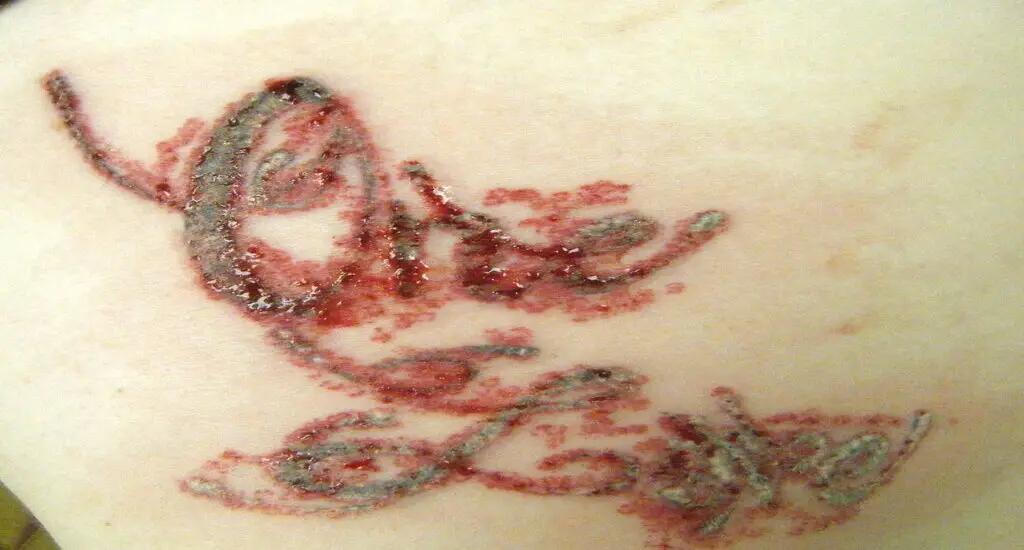This guide provides detailed instructions on how to care for your tattoo after laser removal. We’ll cover each step of the process in depth.

Table of Contents
How to Care for Your Tattoo After Laser Removal: Initial Care
Immediately after your laser tattoo removal session, the treated area will likely be red, swollen, and sensitive. This is a normal reaction to the laser treatment.
The first step in aftercare is gentle cleansing. Use a mild, fragrance-free soap and lukewarm water to clean the area. It’s important to be gentle and avoid scrubbing, as the skin is very sensitive at this stage.
After cleaning, carefully pat the area dry with a soft, clean towel. Avoid using rough or dirty towels as they can introduce bacteria or irritate the skin.
Next, apply a thin layer of antibiotic ointment. This helps prevent infection, a crucial aspect of the healing process. Choose ointments like Neosporin or a similar product recommended by your healthcare provider. Avoid using too much ointment as it can clog pores and slow down healing.
You can get this Neosporin Original First Aid Antibiotic Bacitracin Ointment from Walmart.
Finally, cover the treated area with a sterile, non-stick bandage. This protects the skin from bacteria and physical irritants. Ensure the bandage is secure but not too tight as to restrict blood flow.
Change the bandage at least once a day or more frequently if it becomes wet or dirty. Always wash your hands before handling the bandage to minimize the risk of infection.
Daily Skincare Routine
In the days following your treatment, maintaining a consistent skincare routine is vital for healing.
Continue to gently wash the area two to three times daily with mild soap and water, following the same procedure as immediately after the treatment. Pat the area dry each time and reapply a thin layer of antibiotic ointment for the first few days.
Once you notice the skin starting to heal and scabs forming, it’s time to transition from the ointment to a fragrance-free moisturizer. This change is important to avoid potential irritation from prolonged use of the ointment.
You can get this Lubriderm Advanced Therapy Body Lotion from Walmart if it suits your skin.
A good moisturizer will keep the skin hydrated, which aids in healing and reduces itching. Look for products specifically designed for sensitive skin or post-laser treatment. Apply the moisturizer lightly and evenly, and avoid any products containing alcohol or other irritants.
Sun Protection
Protecting the treated area from the sun is crucial for preventing complications like inflammation and hyperpigmentation. Keep the area covered with clothing or a sterile bandage when outdoors. If the area is exposed, use a broad-spectrum sunscreen with at least SPF 30.
The Equate Sport Broad Spectrum Sunscreen Lotion is a good sunscreen product you can use.
Reapply every two hours when outdoors. This is more necessary if you’re sweating or swimming (though swimming should be avoided in the early stages of healing). Even after the area has healed, continue to use sunscreen as the skin will be more sensitive to UV rays for several months post-treatment.
Avoid Certain Activities
There are several activities and behaviors to avoid while your tattoo is healing from laser removal.
First, avoid swimming in pools, oceans, lakes, or hot tubs. These waters can contain bacteria and chemicals that can irritate or infect the healing skin. Similarly, avoid soaking in bathtubs; stick to showers for the first couple of weeks.
Sweating can also irritate the treated area, so avoid strenuous exercise and activities that cause heavy sweating. Keep the area clean and dry to prevent infection.
In addition, resist the urge to scratch, pick at scabs, or peel flaking skin. These actions can introduce bacteria, increase the risk of scarring, and interfere with the healing process.
Check out these other articles…
Does Tattoo Continue to Fade After Laser Treatment? Answered
Can You Get a Tattoo After Laser Removal? Detailed Answer
Dry Skin After Laser Tattoo Removal: Essential Care Tips
Skin Discoloration After Laser Tattoo Removal: Easy Guide
How Does Skin Look After Laser Tattoo Removal: Easy Guide
Recognizing and Handling Complications
Complications after laser tattoo removal are rare, but it’s important to be aware of signs that might indicate a problem. Symptoms of infection include excessive redness, swelling, heat in the area, pus, or severe pain. If you experience any of these symptoms, contact a healthcare professional immediately.
Blistering, while not uncommon, should be monitored. Blisters should naturally heal on their own; do not puncture them. If you’re concerned about any reaction you’re experiencing, contact the specialist who performed your laser treatment. They can provide specific advice and, if necessary, treatment to address the complication.
Long-Term Care and Considerations
Once your skin has fully healed, it’s still important to continue caring for it.
Regular moisturizing helps maintain skin health. Use a daily moisturizer with SPF to protect the area from sun exposure, which can still affect the skin months after treatment.
If you notice any long-term changes in texture or color, or if you have any concerns about the healing process, consult a dermatologist. They can offer specialized advice and treatments to ensure your skin remains healthy.

